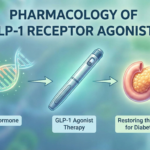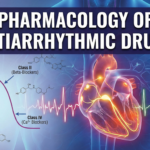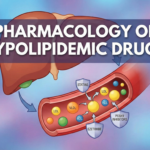Introduction
Amiodarone is a potent, pleiotropic antiarrhythmic agent classified as a Vaughan-Williams Class III drug, renowned for its efficacy in managing a wide spectrum of life-threatening cardiac arrhythmias. Its complex pharmacodynamic and pharmacokinetic features distinguish it among antiarrhythmics, demanding thorough understanding for safe and effective clinical use. Amiodarone is widely utilized for both acute and chronic arrhythmia management, particularly where other agents have proven ineffective or risky.
Chemical Structure and Properties

- Class: Benzofuran derivative, iodine-rich (contains ~37% iodine by weight)
- Physical form: Highly lipophilic, yellow crystalline powder
- Molecular structure: Two iodine atoms, conferring similarity to thyroid hormones and contributing to endocrine adverse effects
- Key Properties:
- High volume of distribution (>60 L/kg), indicating extensive tissue penetration
- Affinity for adipose, hepatic, pulmonary, and ocular tissues—basis for long half-life, slow onset/offset, and multi-organ toxicity
Mechanism of Action
Amiodarone is unique in exhibiting actions aligned with all four Vaughan Williams antiarrhythmic classes:
- Class III (Primary): Prolongs myocardial repolarization by potassium channel blockade (IKrIKr—delayed rectifier K⁺ currents), lengthening the action potential and refractory period in atrial and ventricular myocardium
- Class I: Inhibits voltage-gated sodium channels—moderate membrane-stabilizing effect, slows conduction
- Class II: Noncompetitive beta-adrenergic receptor blocking—decreases sympathetic tone, heart rate
- Class IV: Inhibits L-type calcium channels—influences AV node conduction and automaticity
Other effects:
- Mild noncompetitive alpha-adrenergic antagonism (vasodilation)
- Interference with thyroid hormone (via iodine content)
- Antianginal and anti-ischemic properties
Pharmacokinetics
| Parameter | Details |
|---|---|
| Absorption | Variable oral bioavailability (~30–80%), increased with fatty meals |
| Distribution | Extensive: accumulates in adipose, lung, liver, skin, cornea, thyroid |
| Onset | Oral: days–weeks (loading required); IV: rapid |
| Metabolism | Hepatic (CYP3A4, CYP2C8) to desethylamiodarone (active) |
| Excretion | Hepatobiliary (feces primary), minimal renal |
| Half-life | Highly variable; average 20–100 days (range 15–142 days) |
| Steady-state | Achieved only after weeks of therapy due to long half-life |
- Implication: Slow clearance leads to persistence of therapeutic (and toxic) effects long after discontinuation.
Cardiac Indications and Therapeutic Uses
1. Ventricular Arrhythmias
- First-line for recurrent ventricular tachycardia (VT), ventricular fibrillation (VF)—especially when refractory to other agents or ICD shocks.
- Also used acutely in cardiac arrest for pulseless VT/VF (ACLS algorithms).
2. Supraventricular Arrhythmias
- Atrial fibrillation, atrial flutter: Effective for rhythm control, rate control in difficult cases (esp. with structural heart disease).
- Paroxysmal supraventricular tachycardia (PSVT): Off-label, rescue therapy.
3. Post-Myocardial Infarction (MI) Arrhythmias
- Prevention of sustained ventricular arrhythmias post-MI—used in patients with reduced ejection fraction or structural disease.
4. Heart Failure-Related Arrhythmias
- One of the few agents safe in patients with heart failure (minimal negative inotropic effect).
5. Prophylactic Use
- Rarely used long-term for primary prevention of arrhythmias in high-risk patients.
Dosing and Administration
Oral
- Loading: 800–1600 mg/day (in divided doses) for 1–3 weeks (max 3 weeks)
- Maintenance: 100–400 mg/day (single or divided doses); lowest effective dose recommended
- Titration: Gradual reduction based on response/adverse effects
Intravenous
- Acute VT/VF arrest: 300 mg IV push, followed by 150 mg IV if needed
- Loading infusion for arrhythmia control: 150–300 mg IV over 10–60 min, then continuous infusion (1 mg/min for 6 hours, then 0.5 mg/min as needed)
Note: Monitor for hypotension, bradycardia, infusion reactions during IV administration.
Adverse Effects and Toxicity
Amiodarone’s diverse tissue distribution and metabolic pathways underpin a broad spectrum of toxicities, many dose- and duration-related.
1. Thyroid Dysfunction
- Hypothyroidism: More common, due to inhibition of deiodinase and direct cytotoxicity (up to 20% of patients).
- Hyperthyroidism: Less common, via increased thyroid hormone synthesis or destructive thyroiditis.
2. Pulmonary Toxicity
- Interstitial pneumonitis: Nonproductive cough, dyspnea, fevers—can progress to fatal pulmonary fibrosis.
- Incidence: ~1–10%, higher in elderly and with high cumulative dose.
3. Hepatotoxicity
- Elevated transaminases: Often mild; rarely severe hepatitis/fulminant hepatic failure
4. Cardiac Effects
- Bradycardia, heart block, QT prolongation, risk of torsades de pointes (rare but possible)
- Paradoxical proarrhythmia
5. Dermatologic
- Photosensitivity: Sun exposure ⇒ blue-gray skin discoloration (“smurf syndrome”)
- General skin rash, eczema
6. Ocular
- Corneal microdeposits: Virtually universal; usually asymptomatic, reversible.
- Optic neuropathy/neuritis: Rare but can lead to vision loss.
7. Neurologic
- Tremor, ataxia, peripheral neuropathy
8. Other
- GI: Nausea, vomiting, constipation
- Reproductive/fetal: Teratogenic, contraindicated in pregnancy/lactation
Incidence Table: Adverse Effects by Organ System
| System | Adverse Effect | Frequency |
|---|---|---|
| Thyroid | Hypothyroidism, hyperthyroid | 10–20% |
| Lung | Pneumonitis, fibrosis | 1–10% |
| Liver | Transaminase ↑, hepatitis | 15–30% |
| Cardiac | Bradycardia, AV block | 5–10% |
| Skin | Photosensitivity, rash | 15–40% |
| Eye | Corneal microdeposits, neuropathy | 90–100% (microdeposits) |
| GI | Nausea, constipation | 10–20% |
Contraindications and Cautions
- Severe sinus node dysfunction, 2nd/3rd degree AV block (without pacemaker)
- Severe pulmonary disease
- Thyroid dysfunction (untreated)
- Liver failure
- Pregnancy/lactation
- Hypersensitivity to amiodarone or iodine
Special populations: Use lower doses in elderly, monitor for toxicity more frequently.
Drug Interactions
Amiodarone is a strong inhibitor of multiple CYP450 isoenzymes (CYP3A4, CYP2C9, CYP2D6) and P-glycoprotein.
- Warfarin, dabigatran, other anticoagulants: Increased bleeding risk; monitor INR closely, reduce dose as needed.
- Digoxin: Raises serum digoxin levels; halve digoxin dose when initiating amiodarone.
- Beta-blockers, Calcium channel blockers (verapamil, diltiazem): Compound risk of bradycardia, AV block; avoid combination if possible.
- Statins (simvastatin, atorvastatin): Increase risk of myopathy/rhabdomyolysis—lower statin dose.
- Class I/III Antiarrhythmics: Additive QT prolongation, increased proarrhythmia.
- Phenytoin, cyclosporine, tacrolimus: Increased blood levels and toxicity possible.
Table: Key Drug-Drug Interactions
| Interacting Drug | Recommendation | Monitoring |
|---|---|---|
| Warfarin | ↓ warfarin dose ~30–50% | INR weekly at initiation |
| Digoxin | ↓ digoxin dose 50%, monitor | Serum levels, ECG |
| Simvastatin | Max 20 mg/day (risk myopathy) | CK, muscle symptoms |
| Beta-blocker | Avoid combo if possible | ECG, BP, pulse |
Special Clinical Considerations
Monitoring Requirements
- Baseline and periodic tests:
- Thyroid function (TSH), liver function (LFTs), chest X-ray/pulmonary function, eye examination, ECG.
- Repeat at 3–6 months intervals or as symptoms dictate.
Perioperative Use
- Continue for life-threatening arrhythmia risk unless contraindicated.
- Dose adjustment, monitor for interaction with anesthesia agents (bradycardia, hypotension).
Withdrawal
- Clinically relevant tissue levels persist for weeks–months after discontinuation; adverse effects may develop or resolve slowly.
Clinical Pearls
- Loading required: Due to large Vd and slow tissue saturation, loading doses are needed for rapid effect.
- Low arrhythmogenic potential: Compared to other antiarrhythmics, torsades de pointes is less frequent.
- Patchy bioavailability: Oral absorption variable; switching to IV may be required for acute control.
- Multiorgan toxicity: Educate patients about monitoring symptoms (dyspnea, dry cough, jaundice, vision changes, rash).
Recent Guideline Updates
- ACLS/ACC/AHA Guidelines (2022)
- Amiodarone recommended for VT/VF resistant to defibrillation and epinephrine.
- Not recommended for routine use in atrial fibrillation without structural heart disease due to toxicities.
- Use lowest effective dose long-term; periodic monitoring mandated.
References
- Goodman & Gilman’s The Pharmacological Basis of Therapeutics, 13th Edition
- Katzung BG, Trevor AJ. Basic & Clinical Pharmacology, 15th Edition
- ACC/AHA/ESC 2022 Guidelines for the Management of Patients with Ventricular Arrhythmias
- Rang & Dale’s Pharmacology, 9th Edition
- DrugBank Online: Amiodarone profile
📚 AI Pharma Quiz Generator
🎉 Quiz Results
Medical Disclaimer
The medical information on this post is for general educational purposes only and is provided by Pharmacology Mentor. While we strive to keep content current and accurate, Pharmacology Mentor makes no representations or warranties, express or implied, regarding the completeness, accuracy, reliability, suitability, or availability of the post, the website, or any information, products, services, or related graphics for any purpose. This content is not a substitute for professional medical advice, diagnosis, or treatment; always seek the advice of your physician or other qualified health provider with any questions you may have regarding a medical condition and never disregard or delay seeking professional advice because of something you have read here. Reliance on any information provided is solely at your own risk.









